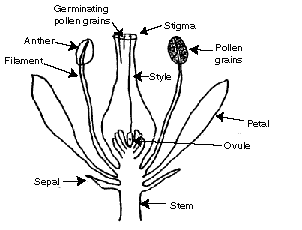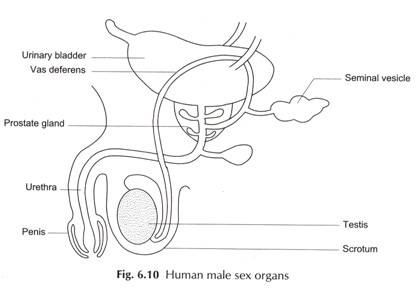Reproduction and
Inheritance
Asexual Reproduction is when a single parent copies its genetic information, forming a
daughter which is genetically identical (clone) to itself. It involves no
gametes and fertilisation.
Sexual Reproduction involves gametes which fuse to create a zygote and eventually an
embryo which is not genetically identical to the parents.
Fertilisation involves the fusion of a male and female gamete to produce a zygote
which then undergoes cell division and develops into an embryo.
Reproduction in
Plants
Insect Pollinated Plant:
Wind Pollinated Plant:

Adaptations of wind and insect pollinated
plants:
Feature
|
Insect Pollinated
|
Wind pollinated
|
Stamen
|
Enclosed - to force insect to make
contact
|
Exposed - so that wind can easily
blow it away
|
Stigma
|
Enclosed - insect must make contact
Sticky - pollen sticks to it
|
Exposed - easier to catch pollen
Feathery - large surface area to
catch pollen
|
Petals
|
Brightly coloured, large and scented
to attract insects
|
Small and not scented or coloured as
there is no need
|
Nectaries
|
Present so as to attract insect
|
No nectary
|
Pollen grains
|
Large, spiky and sticky to attract
insects
|
Small, light, and aero-dynamic so
that it can be easily carried bu the wind
|
Fertilisation:
1. Pollination occurs where pollen is transferred from the anthers to
the stigma. The stigma must be ripe so that chemicals can be produced for the
production of pollen tubes and a sugary substance for energy.
2. The pollen tube grows down through the style and into the ovary. It
enters the ovule by the micropyle.
3. The male nucleus moves out of the pollen grain and moves down the
channel created by the pollen tube and ion the ovule.
4. Fertilisation occurs where the male and female gamete fuse to form a
zygote.
5. The zygote undergoes mitosis in a seed to create an embryo.
Seed and fruit formation:
1. The petals and anthers die as there is no longer any need for them.
2. The ovule wall becomes the testa which protects the embryo.
3. The cotyledon provides the food store for the embryo.
4. The plumule is the embryonic shoot ad the radicle the embryonic
roots.
5. The ovary becomes the fruit.
Germination:
1. The dormant seed is buried in soil.
2. Water is absorbed by the seed through the micropyle.
3. Food reserve (starch) in the cotyledon is mobilised.
4. The testa splits as the seed expands.
5. The radicle grows downwards. The root develops and begins to absorb
water directly.
6. The plumule begins to grow upwards with the cotyledon still fueling
growth.
7. The embryonic leaves of the plumule now clear of the ground and
begin to photosynthesise.
Germination requires:
1. Heat for enzymes to act efficiently.
2. Water for chemical reactions to take place.
3. Oxygen for respiration to release energy.
4. Light is not needed.
Reproduction in
Humans:
Male:

Sperm is stored and created in the testes.
During intercourse it travels along the sperm duct in the penis and mixes with
secreted liquid from the seminal vesicle to form semen. One ovum is released
into the fallopian tube each month and when it is in the tube a sperm can
fertilise it.
Female:
Menstruation:
Hormones are very important for this process.
First the follicle stimulating hormone (FSH) stimulates the growth of the
follicle containing an ovum. At the same time FSH stimulates the release of
oestrogen which begins the re-thickening of the uterus lining and also slows
the release of FSH and stimulates the release of LH (lutenising hormone). When
LH is at its peak, ovulation occurs where the ovum is shed by the ovary. If
sexual intercourse occurs, what is left of the follicle forms a structure
called the corpus lute. This releases progesterone which completes the
thickening of the uterus walls and inhibits production of FSH and LH, stopping
any further ovulation. If the egg is not fertilised then the corpus lute breaks
down and the lining of the uterus is shed through menstruation. Progesterone is
also used during pregnancy to stop menstruation. It is produced by the
placenta.
Placenta:
The placenta allows the
embryo to obtain oxygen and nutrients and get rid of CO2 and excretionary waste
(e.g. urea). The umbilical cord used to carry the blood containing the
substances towards and away from the foetus. The placenta is also responsible
for secreting progesterone in order to maintain a thick layer of endometrium in
the uterus.
Amnion:
The amnion encloses the
foetus and secretes amniotic fluid which protects the foetus from bumps while
the woman is moving.
Secondary Sexual Characteristics:
Boys: controlled by testosterone
• Growth of penis and testes.
• Growth of facial and body hair.
• Muscle development.
• Breaking of the voice.
Girls: controlled by oestrogen
• The breast develops.
• Menstruation starts.
• Growth of armpit and pubic hair.
Inheritance:
DNA or deoxyribonucleic acid contains two
strands of alternating sugar and phosphate groups coiled to form a double
helix. The strands are linked by two nitrogen bases at each "rung".
There are four different bases: Adenine(A), Thymine(T), Cytosine(C), and Guanine(G).
In DNA the bases are always paired. So if on one strand the base is A, the
other must be T and likewise if on one strand it is C then on the other it must
be G.
The nucleus of cells contains chromosomes on
which genes are located. A gene is a section of a molecule of DNA which
dictates a certain characteristic of the organism.
A certain genes can take different forms which
although creates the same characteristic, doesn't create the same exact
feature. For example, a gene may code for green eyes while the same gene might
code for blue eyes. These different forms of the same gene are called alleles.
Alleles give rise to differences in inherited characteristics.
Definitions:
• Genes - a small section of DNA that
determines a particular feature by instructing cells to produce a particular
protein are called genes.
• Alleles - an alternative form of a gene
which gives rise to differences in inherited characteristics.
• Dominant - a feature will always have
two alleles. If one allele’s characteristic is present while the other is not
then it is said to be dominant.
• Recessive - if one allele is dominant
then the other is said to be recessive.
• Homozygous - contains two copies of one
allele (e.g. TT, aa).
• Heterozygous - contains two different
alleles (e.g. Tt, Aa).
• Phenotype - a feature that results from
the genotype.
• Codominance - if two alleles are
expressed in the same phenotype.
• Diploid cells - cells with
chromosomes in homologous pairs are said to be diploid. In humans the diploid
number is 23 meaning each cell has 23 chromosomes.
• Haploid cells - cells with
chromosomes not in a homologous pair is said to be haploid. In humans the
haploid number is 46.
The sex of a person is determined by a pair of chromosomes, XY in a male and XX in a
female. The overall ratio of male and female births is 1:1
This can be shown by this diagram:
X
|
X
|
|
X
|
XX (female)
|
XX(female)
|
Y
|
XY(male)
|
XY(male)
|
Mitosis is
the nuclear division of somatic (body) cells to create genetically identical
cells which are used for growth, repair, asexual reproduction and replacing
worn out cells.
Meiosis
occurs to produce haploid cells that are used in sexual reproduction. It
involves a similar process to mitosis except that there are two divisions
compared to one in mitosis. Meiosis creates four cells, each with half the
number of chromosomes and creates genetically different gametes.
A human male can produce millions of genetically
different sperm cells and a female holds thousands of genetically different egg
cells. This large pool of genetically different gametes and the fact that
fertilisation is random allows genetic variation of the offspring. Not only is
variation produced by genetics, it can also be produced through the
environment.
A mutation is a rare, random
change in genetic material which can be inherited. Many mutations are harmful
but some are neutral and a few are beneficial.
Mutations that are beneficial can cause the
mutant organism to increase in population through natural selection. An example
of this is in bacteria that have mutated to be resistant to antibiotics. The
variation in the species is that there are bacteria that are resistant and
those that are not. The bacteria that are resistant live for longer and can
therefore multiple more while the non-mutated
species die out as they lack the advantage. This means they eventually populate
the entire species.
The chances of mutations can be increased
through mutagens. Examples of these are ionising radiation such as ultraviolet
light, X-rays and gamma rays and many different chemicals, both natural and manmade
(e.g. benzene).
No comments:
Post a Comment